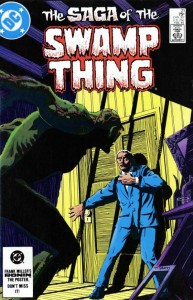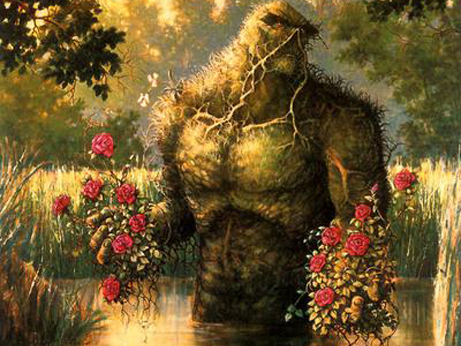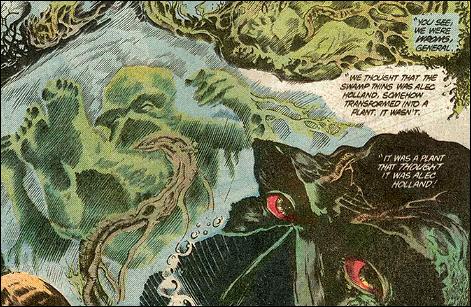
Written by Alan Moore
Pencilled by Stephen Bissette
Inked by John Totleben
Colors by Tatjana Wood
Published by DC Comics
If you walked down a street and asked a random passerby to name a comic book writer or artist, they would probably say Stan Lee. After that, they would probably say Alan Moore. Alan Moore is famous for Watchmen, V for Vendetta, League of Extraordinary Gentlemen, and other books whose film adaptations he has disowned. Before doing these famous and popular comics, he did some work for 2000 AD,Marvel UK, and Warrior where he wrote Marvelman, which was later changed to Miracleman and was a dark deconstruction of the superhero genre. This dark deconstructive theme continued to Moore’s first work on an American comic: DC Comics’ Saga of the Swamp Thing.
Len Wein and Bernie Wrightson created Swamp Thing in 1972 as a hybrid of the horror/superhero genre. Alec Holland had a Silver Age-type superhero origin (getting dosed with chemicals, falling into the swamp, emerging a swamp creature struggling to regain his humanity), but his earliest adventures were illustrated by famous horror artist Bernie Wrightson. After Wein and Wrightson left the title, Swamp Thing fell into infamy, but he got his own title in 1982 to coincide with the Swamp Thing film directed by Wes Craven. This book also suffered from poor sales and was about to be cancelled so editor (and Swamp Thing co-creator) Len Wein gave Alan Moore carte blanche with the book, and he used this lack of editorial interference to tell literary horror stories beginning with his first story “The Anatomy Lesson” which completely turned the concept of Swamp Thing on its head.
From the first page, Swamp Thing‘s creative team shows their command of the comics medium. Alan Moore sets up the story with an air of suspense with the repeated use of the word “blood” as well as foreshadowing some of the political themes by setting the comic in Washington DC. (There are heavy anti-corporate overtones throughout Swamp Thing #21.) Penciller Steve Bissette has a wonderful command of pacing with an establishing shot of the US Capitol before showing Jason Woodrue in his cell and then using a panel structure that looks like bars to frame the cool disdain on Woodrue’s face as the “old man” bleeds out in front of him. But inker John Totleben is the unsung hero of this page and the whole comic. He uses light inks to show the city of Washington DC at night along with many of the talking head scenes between Woodrue and his employer General Sunderland. However, Totleben uses heavier inks for the more terrifying scenes and any time blood, rain, or any kind of fluid shows up in the comic. This heavy inking works particularly well in the “transformation” scenes that begin when Woodrue shows his power to dissolve his skin as the Floronic Man.
up the story with an air of suspense with the repeated use of the word “blood” as well as foreshadowing some of the political themes by setting the comic in Washington DC. (There are heavy anti-corporate overtones throughout Swamp Thing #21.) Penciller Steve Bissette has a wonderful command of pacing with an establishing shot of the US Capitol before showing Jason Woodrue in his cell and then using a panel structure that looks like bars to frame the cool disdain on Woodrue’s face as the “old man” bleeds out in front of him. But inker John Totleben is the unsung hero of this page and the whole comic. He uses light inks to show the city of Washington DC at night along with many of the talking head scenes between Woodrue and his employer General Sunderland. However, Totleben uses heavier inks for the more terrifying scenes and any time blood, rain, or any kind of fluid shows up in the comic. This heavy inking works particularly well in the “transformation” scenes that begin when Woodrue shows his power to dissolve his skin as the Floronic Man.
Colorist Tatjana Wood does an excellent job in the scene revealing the cold, (supposedly) dead Swamp Thing to readers and Jason Woodrue. She uses a pale blue color mixed with white and grey to show the complete lack of vitality that Swamp Thing currently has. This blue contrasts with the green color that symbolizes life (even grotesque life) for the rest of the comic. The combination of Bissette’s pencils, Totleben’s inks, and Wood’s colors create the tragic and horrific character that is Swamp Thing along with Moore’s lucid writing.
In Swamp Thing #21, Alan Moore shows he has an ear for dialogue as well as crafting evocative metaphors and similes. The comic only has two characters that do a lot of speaking (Jason Woodrue, General Sunderland), but Moore does an excellent job portraying their relationship and showing that cleverness and intelligence are superior to money and power. He gives each character a distinctive voice. For example, Woodrue is quiet and cowed around Sunderland, but full of life and a little long winded when he is talking about his scientific work. He isn’t a hero by any means, but has an intellectual curiosity that makes him slightly sympathetic as a character. Bissette uses a close-up panel of Woodrue’s eyes to show how intensely happy he is when he is performing the autopsy on Swamp Thing because this examination could provide a glimpse into his own plant powers as Floronic Man. When Woodrue gets an epiphany in the shower about Swamp Thing’s real origins, Moore’s writing becomes both beautiful and disturbing as he describes Woodrue’s mental breakthrough as “something strong and soft and green thrusting through the dead and petrified grayness”. This describes Woodrue’s thought process as he transforms into the green-yellow Floronic Man while in the shower as well as the new Swamp Thing slowly emerging from the husk of the old one. The first appearance of the “new” Swamp Thing isn’t until page 17, and Moore slowly shows the creature’s emergence. He adds to the suspense with Woodrue’s narration about Sunderland’s ignorance and reliance on computer systems instead of actual security guards. Bissette is also a master of body horror, and his three panel page of Swamp Thing’s green form coming out of his dead body evokes the Chestburster in Alien with additional slimy tendrils as the story continues.
So far I have discussed how “The Anatomy Lesson” is a technically solid horror and suspense story. It is also a great example of revisionism in comics, which is something Alan Moore’s work is known for as his masterpiece Watchmen was a revisionist take on the entire superhero genre. Up to this point, Swamp Thing was like The Thing from Fantastic Four: a hero who looked liked a monster and still had hope of regaining humanity through science. With a little help from microbiology and anthropology, Jason Woodrue discovers that Swamp Thing was actually plant material that fed on the body of Dr. Alec Holland and his bio-restorative formula (which would turn deserts into forests) and thought it was human. This discovery is actually Moore’s re-tooling of the character. Throughout the comic, Woodrue mocks the Swamp Thing’s attempt to be human saying that it was “a plant that was trying its level best to be Alec Holland and that pathetic, misshapen parody downstairs in the cryochest was the closest it could get”. Moore transformed Swamp Thing from a monster hero into just a monster, who happens to still have intelligence and knows that General Sunderland tried to kill it. Bissette, Totleben, and Wood capture Swamp Thing’s primal nature when it emerges by giving it grotesque tendrils over its body and mad, red eyes, and a slavering mouth. He also has a single line of dialogue in contrast with Woodrue’s long monologue about his true origin.
Another change that Moore made to Swamp Thing was making him a dangerous, vengeful figure. Originally, Swamp Thing was a heroic character, who protected the wetlands and nature from various terrorists and supernatural beings, and Moore alludes to this fact when Woodrue talks about Swamp Thing never hurting or killing anyone. However, this new version of Swamp Thing has just realized that he is not human, and that he has been held captive by someone who put multiple bullets in his head and cut him open for “science”. This leads to a frantic, fast-paced climax as Sunderland’s automated defense system and distaste for intellectual things turn out to be his undoing. Sunderland’s death scene is brilliant as Totleben uses small panels and heavy inks to show Swamp Thing closing before using larger panels to show how weak this man with “his atrophied heart” compared to this angry monster. Penciller Steve Bissette eschews the blood and gore of the slasher genre and decides to just show Sunderland’s cold, blue face as Swamp Thing wanders out of his lab. Moore’s writing echoes it in a statement from Woodrue, “The blood doesn’t matter. Just the dying. The dying’s all that matters.” This could act as a thesis for “The Anatomy Lesson”, a horror comic that has been more about suspense and atmosphere instead of the red stuff.
In their first issue of Saga of the Swamp Thing, Alan Moore and artists Steve Bissette, John Totleben, and Tatjana Wood show how to tell a horror suspense story in the comics medium while also reinventing a C-List character in a interesting way. The Swamp Thing has gone from a “weird” hero to a monster, who knows it is not human, but still thinks it is rational. This tragic element gives readers a hook to be interested in Swamp Thing’s future adventures, which will be different from conventional superheroes or one-off horror stories. Moore also reinvents a former Atom villain the Floronic Man into an interesting character in his own right as the narrator of this comic. He makes Woodrue a complex figure, who is sympathetic because he is mistreated by General Sunderland, but also wants to use Swamp Thing’s abilities for his own personal profit.Because of these things, Swamp Thing #21 is a rare comic that works as a stand alone horror/suspense story as well as another chapter in its character’s ongoing storyline.



